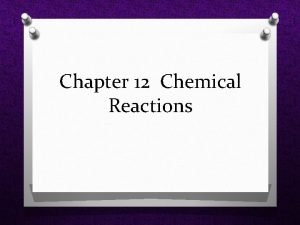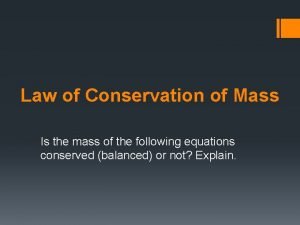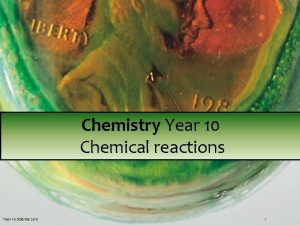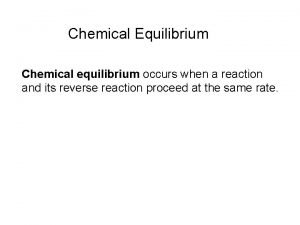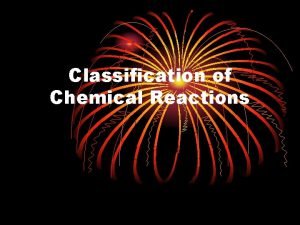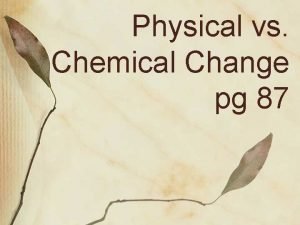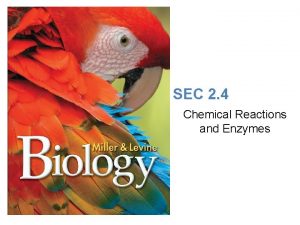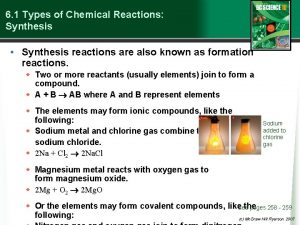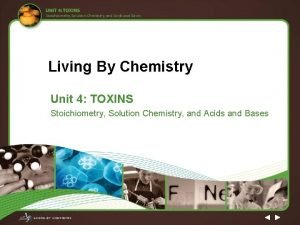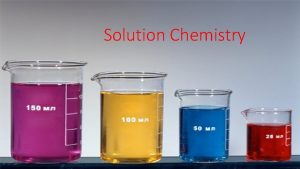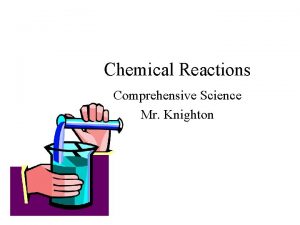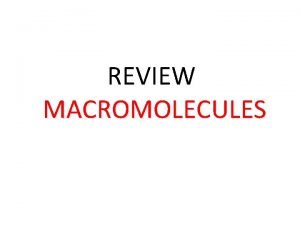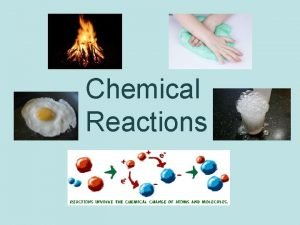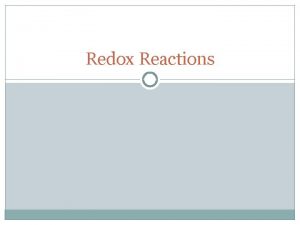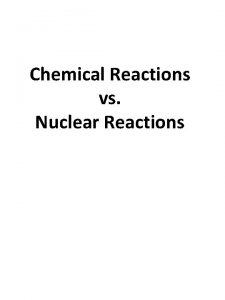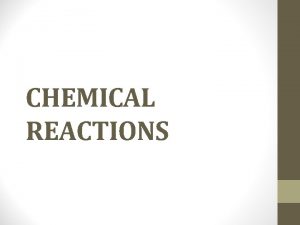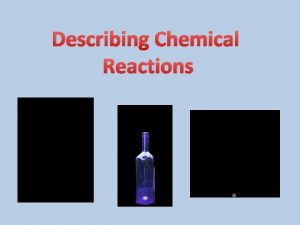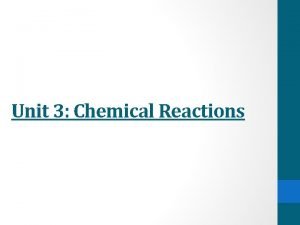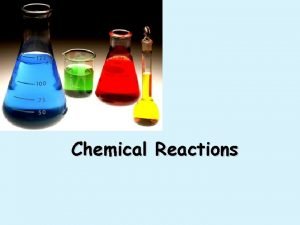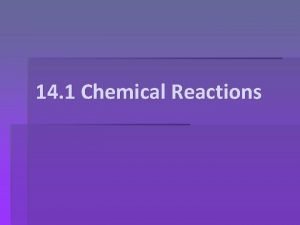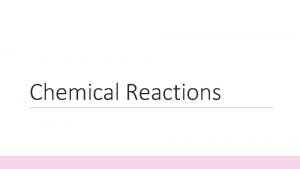Chemical Reactions Understanding Chemical Reactions What are some



































- Slides: 35

Chemical Reactions

Understanding Chemical Reactions • What are some signs that a chemical reaction might have occurred? • What happens to atoms during a chemical reaction?

Changes in Matter • A physical change does not produce new substances. • For example, water molecules are always made up of two hydrogen atoms bonded to one oxygen atom regardless of whether they are solid, liquid, or gas.

Changes in Matter (cont. ) • During a chemical change, one or more substances change into new substances. • A chemical reaction is a process in which atoms of one or more substances rearrange to form one or more new substances.

Signs of a Chemical Reaction • Chemical reactions will always result in a new substance being formed. • Changes in the physical properties of color and odor are all signs that a chemical reaction might have occurred. • If substances get warmer or cooler or if they give off light or sound, it is likely that a chemical reaction has occurred.

Signs of a Chemical Reaction (cont. ) The only way to know if a chemical reaction has occurred is to study the chemical properties of the substances before and after the change. What are some signs that a chemical reaction might have occurred?

What happens in a chemical reaction? • In a chemical reaction, atoms of elements or compounds rearrange and form different elements or compounds. • Atoms rearrange when chemical bonds between atoms break.

Notice that no new atoms are created in a chemical reaction. The existing atoms rearrange and form new substances.

What happens in a chemical reaction? (cont. ) What happens to atoms during a chemical reaction?

Understanding Chemical Reactions • What are the parts of a chemical equation? • How are subscripts and coefficients different?

Chemical Equations • A chemical equation is a description of a reaction using element symbols and chemical formulas. • In chemical equations, element symbols represent elements and chemical formulas represent compounds.

Chemical Equations (cont. ) • A subscript describes the number of atoms of an element in a compound. • If an element’s symbol does not have a subscript, the compound contains only one atom of that element.

Chemical Equations (cont. ) • A subscript is a number placed to the right of an element symbol or chemical formula in an equation. • Subscripts show many atoms are present in a element or compound.

Chemical Equations (cont. ) • A coefficient is a number placed to the left of an element symbol or chemical formula in an equation. • Coefficients tell how many molecules of the compound are present. • Multiply coefficients and subscripts to find the number of atoms in a molecule.

Chemical Equations (cont. )

Chemical Equations (cont. ) • A chemical equation includes both the substances that react and the substances that are formed in a chemical reaction. • The starting substances in a chemical reaction are reactants. • The substances produced by the chemical reaction are products.

Chemical Equations (cont. ) • The reactants are written to the left of the arrow. • The products are written to the right of the arrow. • The general structure for a chemical equation is: reactant + reactant product + product

Chemical Equations (cont. ) An equation is read much like a sentence. This equation is read as “carbon plus oxygen produces carbon dioxide. ”

Chemical Equations (cont. ) What are the parts of a chemical equation?

Understanding Chemical Reactions • How is the total mass of reactants compare to the total mass of the products in a chemical reaction? • Why is it necessary to balance chemical equations?

Conservation of Mass • The law of conservation of mass states that the total mass of the reactants before a chemical reaction is the same as the total mass of the products after the chemical reaction. • Mass is conserved in a reaction because atoms are conserved. • All atoms at the start of a chemical reaction are present at the end of the reaction.

Conservation of Mass (cont. ) Hutchings Photography/Digital Light Source Mass is conserved in the reaction between baking soda and vinegar.

Conservation of Mass (cont. ) A chemical equation is written so that the number of atoms of each element is the same, or balanced, on each side of the arrow.

Conservation of Mass (cont. ) A balanced equation often does not happen automatically when the formulas for reactants and products are written.

Conservation of Mass (cont. ) • Only coefficients can be changed when balancing an equation. • Changing subscripts changes the identities of the substances that are in the reaction.

Conservation of Mass (cont. ) • When no coefficient is present, only one unit of the substance takes part in the reaction.


Chemical Equations (cont. ) How is the Law of Conservation of Mass related to balancing chemical equations?

Understanding Chemical Reactions • What are the different types of chemical reactions?

Types of Chemical Reactions • The breakdown of one reactant into two or more products is one of four major types of chemical reactions. • Each type of chemical reaction follows a unique pattern in the way atoms in reactants rearrange to form products.

Types of Chemical Reactions (cont. ) A synthesis is a type of chemical reaction in which two or more substances combine and form one compound.

Types of Chemical Reactions (cont. ) In a decomposition reaction, one compound breaks down and forms two or more substances.

Types of Chemical Reactions (cont. ) In a single-replacement reaction, one element replaces another element in a compound.

In a double-replacement reaction, the negative ions in two compounds switch places, forming two new compounds. of Chemical Reactions (cont. )

Types of Chemical Reactions (cont. ) How is the Law of Conservation of Mass related to balancing chemical equations?
 Insidan region jh
Insidan region jh Section 2 reinforcement classifying chemical reactions
Section 2 reinforcement classifying chemical reactions Section 2 classifying chemical reactions
Section 2 classifying chemical reactions Understanding chemical reactions worksheet answer key
Understanding chemical reactions worksheet answer key Types of reactions
Types of reactions Section 1 chemical changes
Section 1 chemical changes Are kc and kp equal
Are kc and kp equal Examples of redox reaction
Examples of redox reaction Unit 5 chemical reactions answers
Unit 5 chemical reactions answers Some trust in chariots and some in horses song
Some trust in chariots and some in horses song Some say the world will end in fire some say in ice
Some say the world will end in fire some say in ice Is ice cream countable or uncountable
Is ice cream countable or uncountable What is contact force
What is contact force They say sometimes you win some
They say sometimes you win some Some say the world will end in fire some say in ice
Some say the world will end in fire some say in ice Sometimes you win some sometimes you lose some
Sometimes you win some sometimes you lose some Examples of double replacement reactions
Examples of double replacement reactions State the law of conservation of mass
State the law of conservation of mass Chapter 8 review chemical equations and reactions section 2
Chapter 8 review chemical equations and reactions section 2 Chemical reactions in water
Chemical reactions in water Equilibrium occurs when
Equilibrium occurs when Chemistry in biology section 2 chemical reactions
Chemistry in biology section 2 chemical reactions Chemical reactions classification
Chemical reactions classification Chemistry grade 11 unit 4 chemical kinetics
Chemistry grade 11 unit 4 chemical kinetics The calculation of quantities in chemical equations
The calculation of quantities in chemical equations Unit 5 chemical equations and reactions
Unit 5 chemical equations and reactions Solvent in chemical reactions
Solvent in chemical reactions Section 2-4 chemical reactions and enzymes
Section 2-4 chemical reactions and enzymes How to identify types of chemical reactions
How to identify types of chemical reactions Chemical reactions summary
Chemical reactions summary Toxic reactions chemical equations
Toxic reactions chemical equations Chemical equations and reactions chapter 8 review
Chemical equations and reactions chapter 8 review Solvent in chemical reactions
Solvent in chemical reactions 5 general types of chemical reactions
5 general types of chemical reactions What is this
What is this Four types of chemical reactions
Four types of chemical reactions



